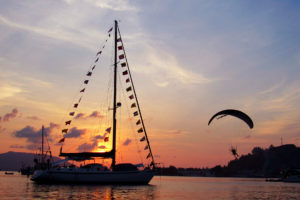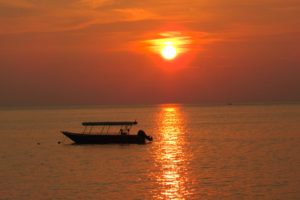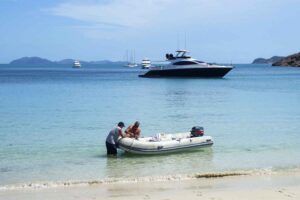Our incredible orangutan experience. Two nights and three days of awesomeness! Awesome place, awesome people, awesome animals, and an awesome experience! I would do this trip again in a heartbeat if given a chance. I loved everything about it. The orangutans and other wildlife we saw, the delicious food, the excellent crew, sleeping on an open boat under a mosquito net, the gorgeous sounds of night descending and the raucous awakening of birds, bugs and gibbons in the morning!
It took us a good couple of days to get there but well worth it… if you are ever in Borneo, do not miss the Tanjung Puting National Park and the orangutans.
Flights to Pangkalan Bun will get you to Kumai and access to the Tanjung Puting National Park. However, we sailed from Pulau Bawean after leaving Java on our yacht. It took us 30 hours to cross the Java Sea from Bawean to Kalimantan, Borneo. For the first 14 hours, we sailed hard on the wind, unable to point as high as we would have liked, but it was still a pleasant enough sail. It was our 11th wedding anniversary, and Dwayne, always the romantic, served me a bowl of chunky Irish Stew after meticulously heating it from the can. We didn’t have candles, but the setting sun put on a glorious show for us! When the sun set, the wind disappeared with it, and we had to motor the rest of the way. The night was very dark, lit only by the extraordinary amount of fishing boats scattered everywhere.
Before long, we had our first visitor. It turned out to be Mr Yono with whom we wanted to book our tour, and soon we had our orangutan tour organised. (Mr Yono’s name had been given to us by friends sailing several weeks ahead of us).
We borrowed Mr Yono’s scooter the next day and rode to Pangkalan Bun, where we bought phone credit, did a little shopping and had lunch. Lunch at a masakan padang, was fascinating. After taking our drink order, they just started putting food in front of us. Dwayne thought he was in heaven! We had eggs, chicken, tempe, beef rendang, goat skin and brains of some sort.
I must admit, I was super excited about the trip to see the orangutans. The Kelotok (our tour boat) arrived to pick us up the following morning, and we left Thorfinn in the capable hands of the boat boy that looked after her at night.
We met the crew and our guide – a great bunch of guys. Joe, our guide, was full of information about the orangutans and other animals, birds, flora and the area’s history. Joe spoke English very well, but when he discovered I was learning Bahasa, he often talked to me in Bahasa, patiently waiting for me to nut out what he said. As we journeyed up the Kumai and then the Sekonyah Rivers, Joe made us a wrist band out of the inner part of a fern stork as he sat and chatted to us about the National Park and his time there as a ranger.
Our delicious food!
Before long, Aan, our cook, asked us what food we liked. He was pleasantly surprised when we told him we would eat almost anything, that we love Indonesian food and sambals. He left us on the deck, enjoying our drinks as, with a massive smile on his face, he hurried down to his galley to prepare lunch.
Aan’s food was delicious, and over the next few days, we were served enormous amounts of delicious prawns, fish, chicken, tempe, vegetables and rice… and he always made us scrumptious sambal to go with each meal.
More Fauna
On the trips up and back down the river, we saw proboscis monkeys, crab-eating macaques, a water snake, a tiny false gharial crocodile and an estuarine croc.
We visited in the wet season and were told that we may not get to see a vast amount of animals as, at this time of year, the wild animals usually go deeper into the forest because the trees are full of fruit. However, we saw heaps of monkeys and got two opportunities to see wild orangutans on the opposite side of the river (not the national park). It was amazing to see them in their natural environment.
Tanjung Harapan
We opted for a two-night / three-day trip that visits the three ‘camps’, each of which has a daily feeding time. Our first stop was Tanjung Harapan. This area was opened in 1982, when 49 orphan orangutans were raised there.
We didn’t have long to wait before “King”, the alpha male, arrived. With a lot of crushing, rustling and swaying of the trees, we could hear him coming long before he swung into view.
King wasted little time, barely giving us a glance before, hanging in an ungainly manner and consuming large amounts of fruit, entirely at ease with being the centre of attention.
A few other orangutans crept closer but stayed hidden in the forest until King (who is enormous – although Joe says he is only medium size) had had his fill and left the area. That was when an older, smaller male walked past and braved the exposed platform to eat some fruit.
We also saw a female orangutan with her baby, and on our way back to the kelotok, and glimpsed a red-leaf monkey swinging through the trees.
Back on the Kelotok, Agus, our skipper, headed further upstream to find a spot to stop for the night. We played cards with the crew, they taught us a game, and we, in turn, showed them one of ours. Much laughter ensued, as is always the way when learning a new game with a little language barrier. Playing cards that night was an animated, fun experience full of smiles and hysterics!
Udin made up our bed with a big mozzie net to protect us from the creepy crawlies of the night. A bit of lightning and thunder increased the night’s ambience, competing with nighttime forest noises. The nighttime cacophony, made up mostly of insects and frogs, gradually gave way to the call of birds and the woorp, woorp, woooo of the gibbon as the sun rose on another glorious day.
We awoke on our third day to the sounds of the bulbul and spider hunter birds. After breakfast, we started to make our way back down the river. We saw a water snake, crocodile, wild orangutans, crab-eating Macaques, colourful birds and copious amounts of proboscis monkeys.
Pondok Tanggui
Our first stop on the second day was at Pondok Tanggui. This camp began in 1992 with the rehabilitation of 27 orphan orangutans. Before going to the feeding platform, Joe took us down a little used path to show us what he called a ‘condom’ plant. It is one of the many carnivorous species found in Borneo. When it is still closed, the liquid in it is used as medicine for the stomach.
On this walk, we saw orangutan scat, and Joe showed us the fern he uses to make the wrist bands. He showed us how to strip back the stem to get the piece he uses for bands. We didn’t see any orangutans at this feeding station. Instead, Joe taught us how to make a band with the fern stem. He made us both a ring while we waited for the orangutans to show. It was a no-show by the orangutans, but we got to see some colourful butterflies, a giant stick insect and taste a jungle fruit which was some sort of wild mango.
Camp Leakey
Camp Leakey was the last spot we visited. As we turned off the Sekonyah River into a small tributary river, you could clearly see the different water colours. The main river is polluted by the illegal alluvial gold mines that still operate up the river. The river has also been impacted by the many palm oil plantations. Joe pointed out the canals dug to take water to the plantations. Not only does the water that flows back down the channel pollute the river with mud, pesticides and fertiliser, but the amount of water that the palms need each day has reduced the flow of water in the river. Joe said each palm needs about 15-20 litres of water per day, which has dramatically impacted the water levels since 2010.
When we first arrived at Camp Leakey, we saw an orangutan and her baby in the tree near where the boat stopped. There was also a female orangutan lying on the walkway. Joe explained that 10 years ago, the orangutan had cancer and had a hysterectomy. Since then has been very lazy. We all had to walk around her.
On our walk to the feeding station, we were given different types of jungle fruits to try; most were delicious. We saw a gibbon feeding in one of the trees. He got our attention because he dropped fruits on us as we passed below.
The research station is at Camp Leaky, and it has an information centre which, although starting to look a little aged, is very interesting.
At Camp Leakey, we saw a couple of male orangutans and a female with a juvenile and a baby. At one stage, a male was on his way to the platform and the female, who was there eating fruit with her baby, left in a hurry walking right by me as I was taking photos. Unbelievable!
The orangutans you see at the feeding stations are what they call ex-captives. They are the orangutans that have been orphaned, rescued from captivity and rehabilitated. The ex-captive orangutans and their offspring are the ones that visit the ‘camps’. We also learned that wild orangutans spend 90% of their time in trees, very rarely standing. However, the ex-captive orangutans stand or walk perhaps 50% of the time.
After a stop at the resort and a village, we were dropped back at Thorfinn. We invited Joe and the crew on board for a look around Thorfinn. Later we were joined by Joe’s wife and his baby daughter as we chatted in the cockpit. It was a wonderful time with beautiful people.
A day with Aan
The following day we filled up with fuel and went shopping for fresh fruit and veg at the markets with Aan.
After dropping the shopping back to the boat, we went for lunch with Aan and watched a parade. From what Aan explained to me, it was a Muslim celebration, and the parade was made up of mostly school kids etc. The bands were great, and it was a lot of fun.
We sometimes felt like we were on show. People from the parade would wave at us, and some took photos! We also had several spectators and even parade participants want to take a picture with us… it’s very amusing, though we are used to people wanting to take our photo; our popularity proceeds us everywhere we go! LOL
Next up – Karimata Islands
More Information
Currency
IDR – Indonesian Rupiah written here as Rp
River Boat Orangutan Tour
Guided Orang-utan Tour – Mr Yono
Our guide Joe Bowo – ph:+62813 5279 2419 and Email: [email protected] (excellent guide).
Our tour – 2 nights / 3 days everything included. Kelotok (the boat), food, bedding including mozzie net, water, tea, coffee, cold shower and toilet. Guide, skipper, cook, decky and boat boy to watch our boat and any national park entrance fees.
Cost – Rp 5,700,000 (about AUS $570)
Don’t forget to – take insect repellant and anything you want to drink besides water, tea and coffee.
Kumai
ATM – Everything I read said there was no ATM at Kumai. That has changed. There is an ATM on the main street across from the ferry terminal.
Food & Eating – Lots of Warungs to eat at. Fresh fruit, veg and seafood available at the markets. A few mini marts as well.
Alcohol – No alcohol, though if desperate, someone can find Bintang beer for you… but it is expensive. Ask your tour organiser.
Diesel – For cruisers needing diesel or petrol, ask the tour organiser they can usually organise it for you.
Pangkalan Bun
Small city / large town – supermarkets, department stores, restaurants, warungs, NO ALCOHOL. You may find beer at a few hotels.
Accommodation
When not on the orang-utan tour, we travelled with our home “Thorfinn” and did not need to find accommodation. I think you’d find some accommodation in Kumai and Pangkalan Bun. If you are joining a tour, your accommodation will probably be supplied. If, however, you are travelling “freestyle”, have a look at Booking.com for some great deals.
Booking.com
iVisa
iVisa makes getting a visa super easy. You can even get passport and visa photos done!
Travel Insurance
Do you have insurance organised for your travels? Take a look at our Travel Insurance page to get a quick quote! I just booked travel insurance with World Nomads again and it always impresses me how quickly I get the quote, and in fact, the entire process, from quote to policy in hand, only takes minutes. Furthermore, you can book when you are already overseas, as I did this time!
Photo Credit -Tanjung Puting National Park by Jorge Franganillo (Attribution 2.0 Generic (CC BY 2.0))
Like this post? Please share or pin using the image below… thank you!














5 Comments
Leave your reply.